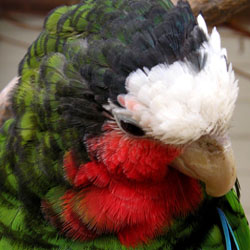Get the Scoop on Poop
 Your bird's poop is valuable in providing insight into your bird's health status. A change in the droppings can be your first gauge that something is wrong with your parrot companion.
Your bird's poop is valuable in providing insight into your bird's health status. A change in the droppings can be your first gauge that something is wrong with your parrot companion.
Observation and determination of what is a normal range of variation in your bird's droppings will help you assess when the situation becomes "abnormal". You should note such factors as the frequency, volume, color, texture, shape, and smell of your bird's droppings. The use of white paper, newspaper or wax paper as cage liners for your parrot’s cage will visually display droppings the best. Making a habit of checking your parrot’s droppings daily will serve as a great early detection system for illness.
"Normal" droppings are seen as a long tube in the shape of a coil with clear urine surrounded by white or off white urates. Poop consists of three different components:
- Feces are the dark, firm portion which are usually tubular in shape.
- Urates, the result of digested and metabolized proteins, are typically off-white to yellowish in color.
- Urine, the liquid waste from the kidneys, is the clear liquid portion.
It is important to note that some variation in poop characteristics are natural depending on diet. For example:
- Large amounts of fruit will result in an increase in urine content
- Colored pellets will often result in colored poop.
- Uncolored pellets will result in brown poop.
- A diet high in greens or seed will create green poop.
- Blueberries can result in dark poop.
- Urine output will vary with water intake.
- Urine and urates can pass independently from feces and an all liquid dropping shouldn't be mistaken for diarrhea.
However, some changes in droppings are due to illness: For example,
- The volume of solid poop is an indicator of the volume of food consumed. If the volume of feces drops this may be an indication your bird is not eating.
- If the volume of urine is consistently low this could be the result of dehydration. An increase in urine output often occurs when a bird is stressed.
- The shape of feces is normally tubular (the shape of the intestinal tract). If the feces are unformed this indicates a case of diarrhea.
- The color of the poop is largely influenced by the bird's diet but:
- dark, tarry feces indicate that your bird has stopped eating
- red or dark brown poop could be the result of blood which indicates either internal bleeding, the presence of parasites, poisoning, or tumors
- red or brown urates are indicative of metal poisoning
- green or yellow urates or urine can be an indicator of liver disease or infection.
- Parrot poop typically is not very smelly. If a strong odor is suddenly detected then this could be a sign of illness.
- Unusual texture changes or the presence of undigested seeds can indicate digestive tract problems. Bubbly or foamy looking poop often indicates a clostridium infection.
If the observed changes are consistent for more than 1-2 days and they are not readily explained by dietary variations, then you should consult your avian vet as soon as possible. Be prepared to take fresh samples of your bird's droppings in a plastic bag to your vet's office for further examination.







Comments powered by CComment